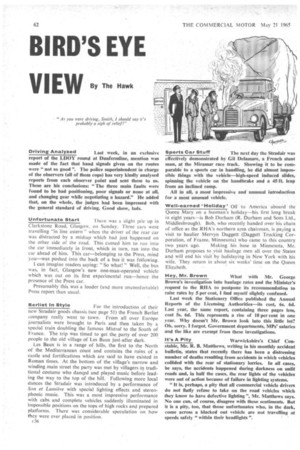BIRD'S EYE
Page 64

If you've noticed an error in this article please click here to report it so we can fix it.
VIEW By The Hawk
"As you were driving, Smith, I should say it's probably a sigh of relief!"
Driving Analyzed Last week, in an exclusive report of the LDOY round at Dunfermline, mention was made of the fact that hand signals given on the routes were "not so good ". The police superintendent in charge of the observers (all of them cops) has very kindly analysed reports from each observer point and sent them to us. These are his conclusions: "The three main faults were found to be bad positioning, poor signals or none at all, and changing gear while negotiating a hazard." He added that, on the whole, the judges had been impressed with the general standard of driving. Good show, lads.
Unfortunate Start There was a slight pile up in
Clarkstone Road, Glasgow, on Sunday. Three cars were travelling "in line astern when the driver of the rear car was distracted by a mishap which had just happened on the other side of the road. This caused him to run into the car immediately in front, which in turn, ran into the car ahead of him. This car—belonging to the Press, mind you—was pushed into the back of a bus it was following.
I can imagine readers saying: "So what! " Well, the bus was, in fact, Glasgow's new one-man-operated vehicle which was out on its first experimental run—hence the presence of the Press car.
Presumably this was a louder (and more uncomfortable) Press report than usual.
serliet In Style
For the introduction of their new Stradair goods chassis (see page 51) the French Berliet company really went to town. From all over Europe journalists were brought to Paris and then taken by a special train doubling the famous Mistral to the South of France. The trip was timed to get the party of over 200 people to the old village of Les Baux just,after dark.
Les Baux is in a range of hills, the first to the North of the Mediterranean coast and contains the ruins of a castle and fortifications which are said to have existed in Roman times. At the bottom of the village's narrow and winding main street the party was met by villagers in traditional costume who danced and played music before leading the way to the top of the hill. Following more local dances the Stradair was introduced by a performance of Son et Lumiere with special lighting effects and stereophonic music. This was a most impressive performance with cabs and complete vehicles suddenly illuminated in impossible positions on the tops of high rocks and prepared platforms. There was considerable speculation on how they were ever placed in position.
c36 serliet In Style
Sports Car Stuff The next day the Stradair was effectively demonstrated by Gil Delamare, a French stunt man, at the Miramar race track. Showing it to be comparable' to a sports car in handling, he did almost impossible things with the vehicle—high-speed induced slides, spinning the vehicle on the handbrake and a 45 ft. leap from an inclined ramp.
All in an, a most impressive and unusual introduction for a most unusual vehicle.
Well-earned 'Holiday' Oil to America aboard the Queen Mary on a busman's holiday—his first long break in eight years—is Bob Durham (R. Durham and Sons Ltd., Middlesbrough). Bob, who recently handed over his chain of office as the RHA's northern area chairman, is paving a visit to haulier Mervyn Daggett (Daggett Trucking Corporation, of Frazee, Minnesota) who came to this country
two years ago. Making his base in Minnesota, Mr. Durham proposes to visit haulage men all over the States and will end his visit by holidaying in New York with his wife. They return in about six weeks' time on the Queen Elizabeth.
What with Mr. George Brown's investigation into haulage rates and the Minister's request to the RHA to postpone its recommendation to raise rates by 5 per cent, I find myself slightly confused.
Last week the Stationery Office published the Annual Reports of the Licensing Authorities—its cost, 6s. 6d. Last year, the same report, containing three pages less, cost 5s. 6d. This represents a rise of 18 per cent in one year. Why doesn't Mr. Brown look into this little lot? Oh, sorry. I forgot. Government departments, MPs' salaries and the like are exempt from these investigations.
Hey, Mr. Brown
























































































































